
Aerial view of National Fire Research Facility
Built to House an Inferno
The National Fire Research Laboratory aims to make buildings better and safer.
When the voice over the intercom announces, “We are clear for ignition,” instead of the deafening roar of a rocket engine, here at the National Fire Research Laboratory (NFRL) in Gaithersburg, Maryland, things stay pretty quiet.
Inside a 9.1- by 4.6-meter (30- by 15-foot) wood structure furnished like a studio apartment, a firefighter crouches in the corner. He uses a propane torch to light a small gas pilot flame, then leaves to join his colleagues outside, where they will wait…and watch.
The structure sits beside an identical one in the middle of the lab’s massive high-bay. The bay’s precisely engineered floor measures 18 by 27 meters (60 by 90 feet), and its ceiling disappears into shadow more than 12 meters (41 feet) above. What appears to be a giant canvas tent suspended from the ceiling is actually an exhaust hood, ready to guide smoke and gases from the fire into an environmental control system that will scrub toxins from the air before it’s released outside.
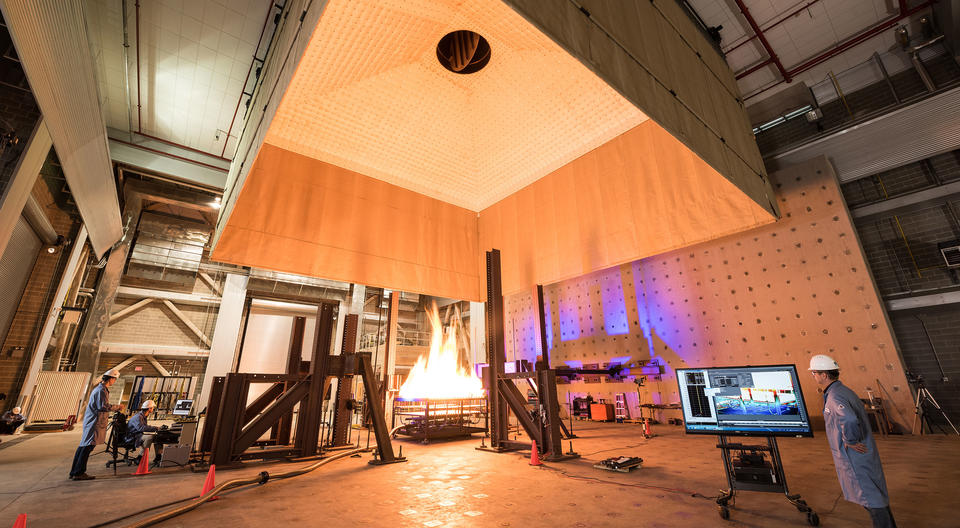
“Once the data and video start recording and everyone is in place, I get calm,” says fire scientist Matt Bundy, the NFRL’s director of operations. “All the preparation is done; all the decisions have been made. I am certainly more nervous, more stressed about the whole thing, the day before and the hours leading up.”
The lead-up to a test like this can take years. The NFRL, which is part of the National Institute of Standards and Technology (NIST), got involved in this project in 2016, but the National Research Council Canada and its partners at the Fire Protection Research Foundation had spent the preceding two years preparing for it. The entire experiment—which involves the construction and burning of six identically furnished rooms over the course of eight weeks—focuses on determining how a new type of construction behaves in a fire.
Called cross-laminated timber, this type of construction material is currently approved for buildings with up to six stories. Designers would like to use it in taller buildings because it is environmentally sustainable and can speed the construction process. To use it for those taller buildings, the industry needs to understand how the timber would perform during a fire, so these experiments are measuring its structural performance and the amount of energy the timber contributes to the fire.
How Can We Make Buildings More Resilient to Fire?
As Bundy and the project team look on, the fire in the test room spreads from a small gas burner to a side table. It grows to consume a kitchenette, a couch, a bed and eventually climbs the walls of the compartment. Multiple cameras record the fire’s growth, capturing a dramatic scene as the room brightens and then becomes obscured by thick, black smoke descending from the ceiling as a thick mass. The smoke finds the door and pours out and up toward the exhaust hood. About 10 minutes into the test comes the flashover, when all that smoke bursts into flames.
“It’s a very rapid transition,” says Bundy. “The room heats up and all that fuel—the furniture—is going from solid to gas, or pyrolyzing. You can get the conditions where the fuel is pyrolyzing faster than it can burn, so you have more fuel than oxygen in the room. When it finds oxygen, it ignites. It can be quite intense and impressive to watch.”
A History of Fire Research
These fire research experiments are just the latest that NIST has been conducting since the early 1900s.
“NIST has a very long history of conducting problem-oriented and applied research in the area of fire safety,” says Bundy. “For example, the mattresses that you buy now are safer because of the work that was done in our fire laboratory.”
NIST’s research has helped improve product safety codes for fire resistance for a variety of products, including furniture, children's sleepwear, automatic sprinklers and even cigarettes that are less likely to start a fire. The research also has led to modernized building codes and computer models that can predict the behavior of fire, smoke and toxic products. These computer models are now widely used for training firefighters and guiding fire protection engineering.
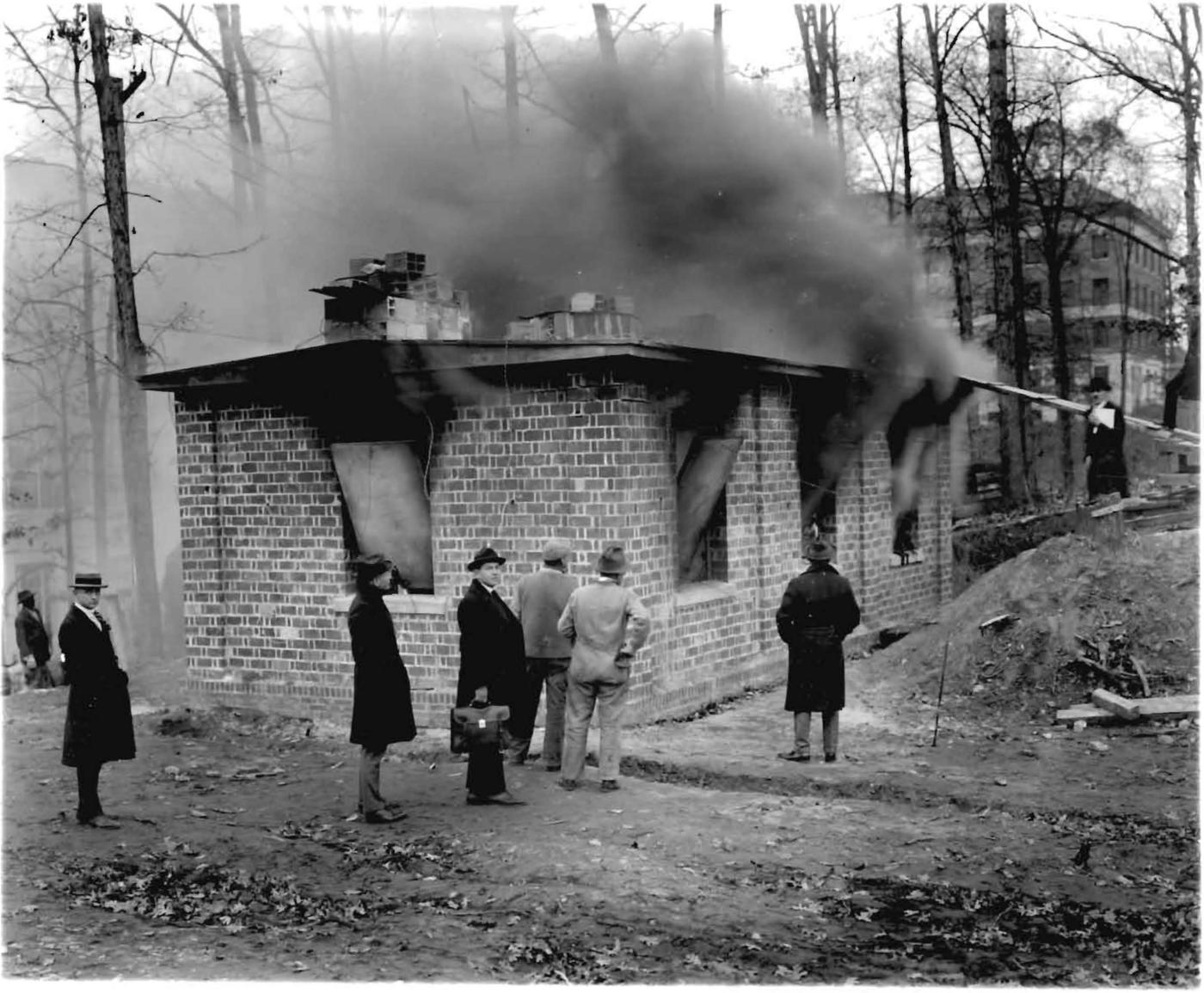
NIST has been conducting fire research since its earliest days. This 1922 photo shows NIST researchers observing a structural fire.
In addition to laboratory work, for more than 90 years NIST researchers have conducted on-site investigations of building fires and structural failures, often leading multi-organization studies of these disasters. NIST’s exhaustive, six-year investigation into the World Trade Center disaster not only revealed the need for a new type of facility to test the fire performance of real-scale structures, but it also led to a total of 40 changes to national and international model building and fire codes.
In 2015, construction was completed on an expansion to NIST’s existing fire research laboratory, which had been in use since 1973. The expanded facility can hold structures up to two stories tall and contain fires up to 20 megawatts of peak energy. That’s equivalent to a small home engulfed by fire and double the heat release rate capacity of the previous fire laboratory.
“NIST has a very long history of conducting problem-oriented and applied research in the area of fire safety"
In addition to increasing the scale of the fires that could be studied in the lab, the expansion added the ability to combine fire science and structural engineering. A new system allows researchers to apply forces to the components of a structure—its beams, columns, floors and walls—to simulate the pushes and pulls of a much bigger and heavier building.
“We can use hydraulic actuators, which are devices used to generate a mechanical force to apply typical gravity forces on a multistory building,” says Lisa Choe, a research structural engineer at the NFRL. The actuators pull on the structure through any of 1,218 holes in the 1.2-meter thick “strong floor,” or through 420 holes in the vertical strong wall, which simulates forces in a wider building than can be built in the lab.
“What this means is we can squish it at the same time we burn it,” says Nelson Bryner, chief of NIST’s Fire Research Division.
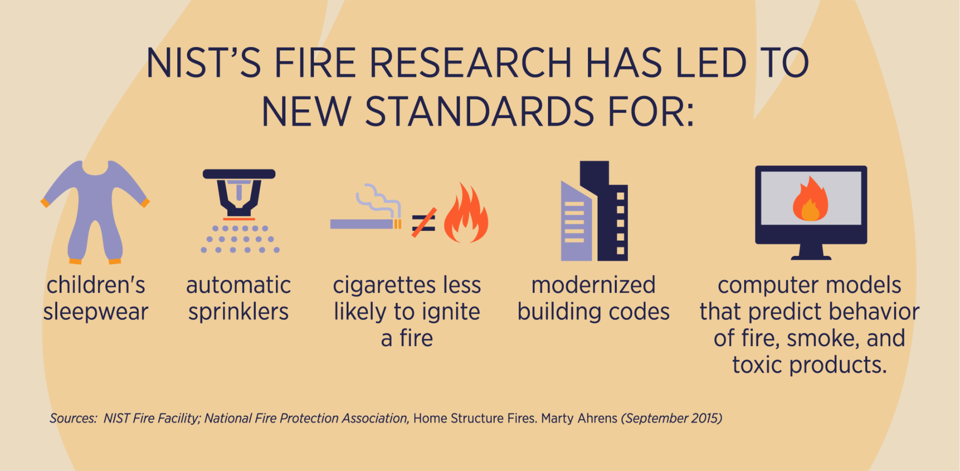
The World Trade Center disaster highlighted the need for this capability, says Bryner. That was because before Building 7 of the World Trade Center (WTC 7) collapsed, a high-rise in the United States had never been brought down by fire. The heat from the uncontrolled fires in WTC 7 caused steel beams to expand and become displaced; the building no longer functioned as designed.
“We didn’t appreciate that fire could impact structural integrity to the point of causing that entire building to fail,” says Bryner.
The experiments conducted at the expanded facility will generate a more realistic set of data indicating how a real structure would behave in a fire.
A New Type of Research
“What’s unique about this facility is that the entire building is a giant measurement device,” says Bundy. “For each fire, we can make unprecedented measurements of energy and chemical output, and determine how a developing fire affects structures. This will inform structural engineers so they can build with fire and structural load in mind and make buildings safer for their occupants and emergency responders.”
The researchers are looking to capture two categories of measurements: fire-related (the heat release rate, temperatures and heat fluxes) and structure-related (forces, strains and displacements).
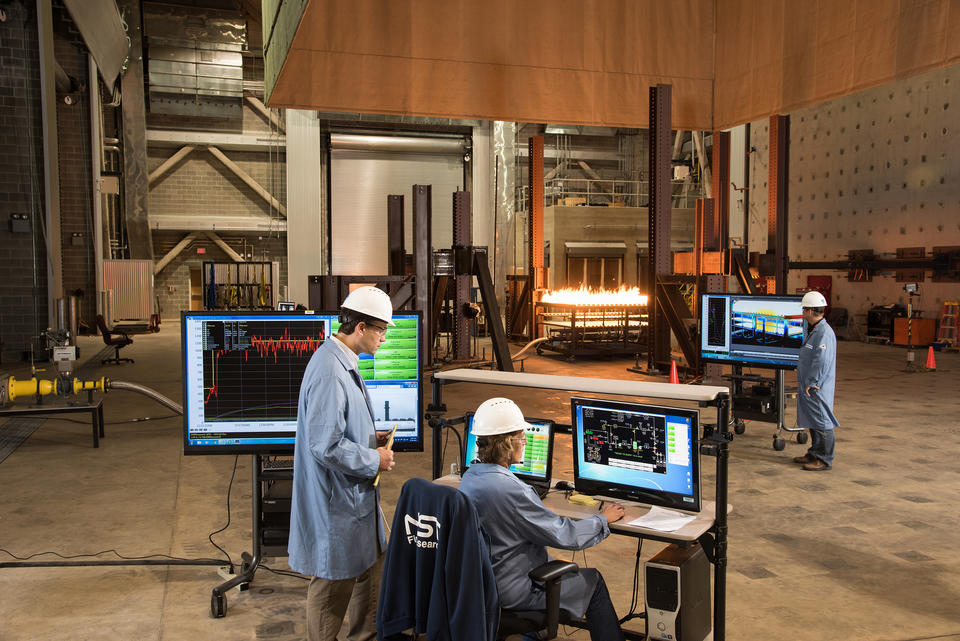
“Displacements give us a sense of the overall behavior of the structure,” says NFRL structural engineer Matt Hoehler. “Strain characterizes the local deformation of a material, and force tells us how much load is on a structure. It’s through a combination of these measurements that we understand how a structure is performing.”
“It is a greenfield for structural fire metrology,” he says. “This lab provides a platform for unique contributions for the next 10 to 20 years.”
Because this capability to combine fire and structural engineering research is new, says Bryner, some of the measurement science is still under development. “We’re looking at laser-based systems and fiber-optic-based measurements to give us the tools to track deformation of steel or cracking of concrete.”
Bringing together two research areas has brought changes to the lab that Bundy welcomes. “Before the new lab, the focus was solely on fire-related projects, and our staff did not typically develop experimental plans. We had researchers come and bring us concepts that we would execute,” he explains.
But now, says Bundy, “We’ve reimagined ourselves.” Structural engineers have joined the lab’s fire scientists to help take full advantage of the new facility. “Now we have our own in-house research in addition to working with outside researchers. We have project leaders and folks with different levels of experience with fire.”
Built to House an Inferno: The NIST National Fire Research Laboratory
Hoehler, for example, worked in earthquake engineering before he joined the NFRL in 2014.
“I studied geology and structural engineering in college. I never imagined I’d be doing large-scale fire tests,” he says. “But it’s still about extreme loads that last for a brief time. Whether it’s an earthquake, an explosion or a fire, it’s about how you take these short events and look at the impact on the structure and figure out where its weak spots are.”
No Culture Clash Here
Despite the inevitable cultural differences between different research disciplines, the transition to having structural engineers working side by side with fire scientists has been pretty smooth, both researchers say, and they’ve been learning from one another.
“I see the structural guys getting excited about the heat release and temperature gradient and gas concentrations, things that aren’t in their training,” says Bundy.
Structural engineer Hoehler says he has gained greater appreciation for the concept of uncertainty since joining NIST’s Fire Research Division. For measurement scientists, a measurement isn’t complete until you determine how uncertain it is, based on the limitations of your tools and understanding of the measurement.
“Structural engineers are often focused on failure mechanisms and the global behavior of the structure,” says Hoehler. “These are huge test specimens—entire buildings—they usually aren’t the kind of experiments you repeat several times to characterize the uncertainty.”
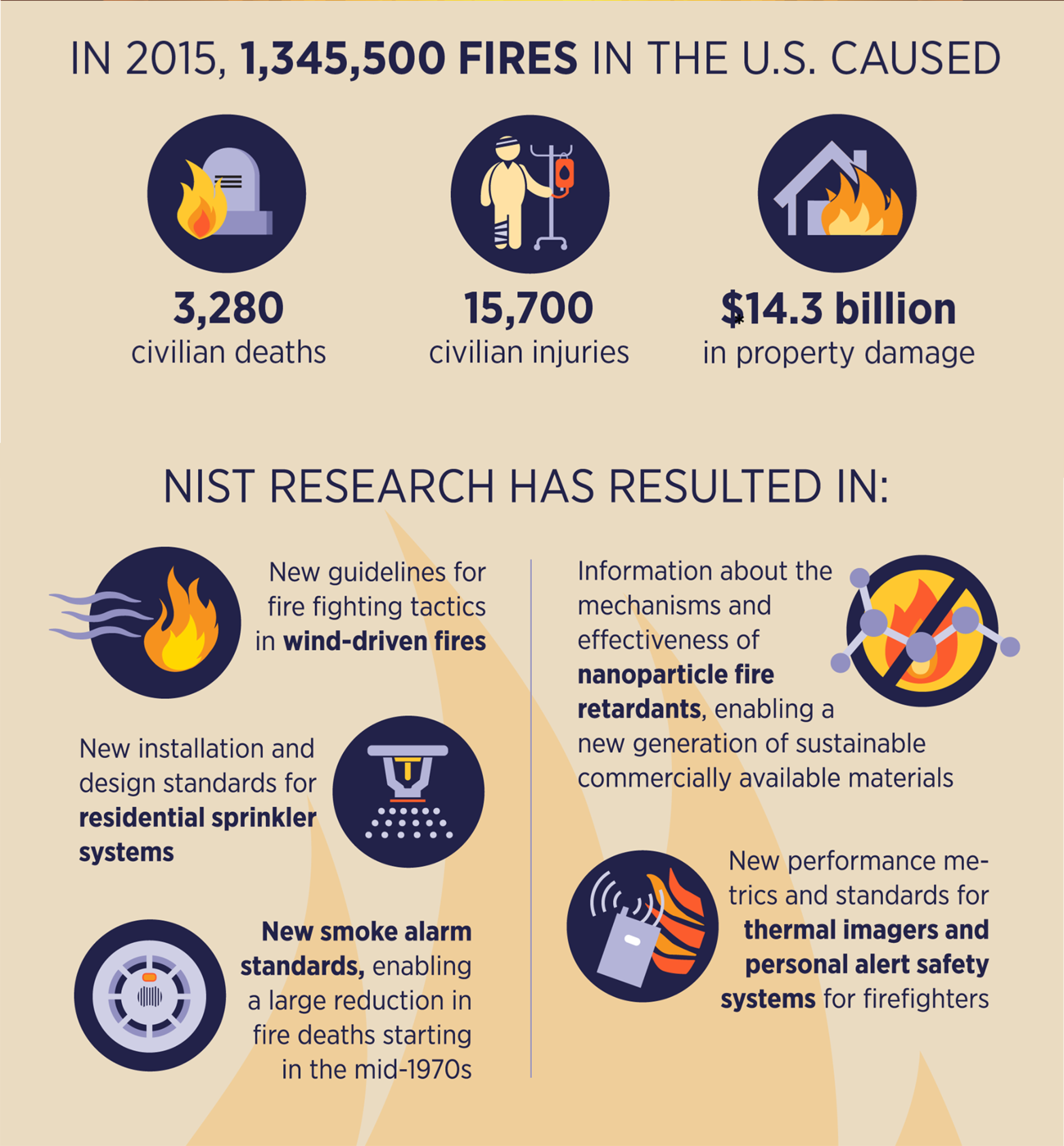
Source: National Fire Protection Association.
Instead, uncertainty is accounted for in engineering practice by using “safety factors,” basically designing structures to be stronger than they need to be. As researchers do a better job characterizing the uncertainty in their work, says Hoehler, structures can be designed more efficiently.
“There are also differences in the lingo and the way things are described,” says Bundy. “Structural engineers in the U.S. are more married to architectural terms and units because that’s the environment they’re in. We have to speak two languages.”
“We all do agree on safety, however,” says Bundy. “Everyone wants to go home safe, and there’s lots of cultural appreciation of safety from both teams.”
Back to the Fires
After several hours of attentively watching the final cross-laminated timber structure burn, the firefighters move in to extinguish the flames. The next day, the team deconstructs what is left of the rooms and removes the debris so that construction for the next series of experiments can begin.
Next up is a project to evaluate the fire performance of steel and concrete composite floor systems, led by Choe. She came to NIST shortly after finishing graduate school in structural engineering, where she had the opportunity to study fire even though it wasn’t necessarily her intention.
“Graduate students often don’t have a choice. The professor gets the research funding,” explains Choe, who is quite happy to have had that early fire research experience, which led her to NIST. Her advisor’s funding from the National Science Foundation and NIST was for an investigation of structural steel members at elevated temperatures. But in a university setting, burning an entire structure is usually not an option. Instead, Choe used radiant heaters to heat building materials, such as steel beams and concrete slabs, that were noncombustible.
“At the NRFL, we can actually burn the building contents,” says Choe. “We can characterize the fires, the heat release, heat flux and actual gas temperature that the structural elements are exposed to. In a typical university structural lab, you don’t have a suite of fire measurement capabilities.”
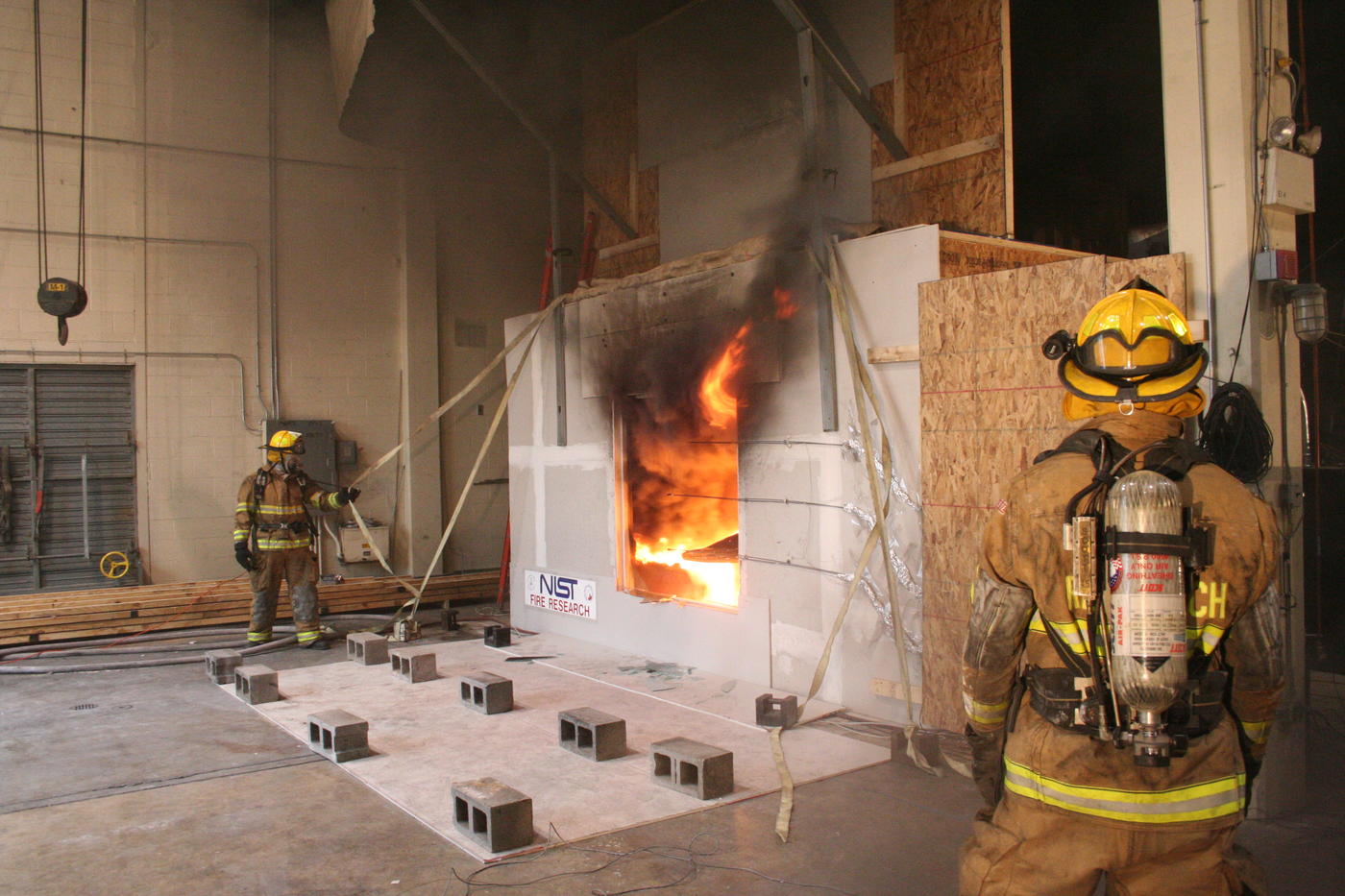
Choe and others have been working on the composite floor project for several years already. There was the initial planning and then stakeholder meetings with experts from different countries and fields, from industry and academia. Throughout the summer and fall of 2017, her team will conduct five burns to determine how a fire affects the performance of 13-meter (42-foot) composite beams. This will be the first test at the new NFRL that will fully use its structural load capabilities.
The composite floor systems Choe is studying and the cross-laminated timber Hoehler and Bundy burned are just two examples of building materials that need to be studied.
“As new materials and construction types come into use, we need to understand what could cause a problem during a fire,” says Bryner. “Can the material or design handle a heavy load but not a quick change in temperature? This facility offers an exciting opportunity to give the construction and fire communities new capabilities to help them improve building design and fire protection.”
“This is kind of a dream come true for me,” says Choe. “I think it’s very cool stuff. And hopefully I can contribute to that work and we can advance building design codes and support safe design for buildings. That’s our goal.”
How Did They Do That?
Writing and research contributed by Jonathan Sunderman.

